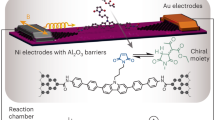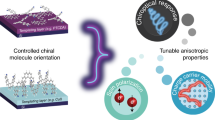Abstract
Conventional methods of asymmetric synthesis of organic compounds involve the use of either chiral catalysts or stoichiometric amounts of chiral substrates. Invariably, the reacting components must be in close proximity to the entity that introduces chirality1,2. But supramolecular chemistry3–5 has shown that stereochemical information can be transmitted through greater distances than are commonly involved in asymmetric syntheses. Here we show that chiral information can be transmitted with remarkable selectivity through as many as nine achiral connecting atoms to give predominantly one diastereomer of a possible four. This contrasts with the general expectation6 that a decrease in selectivity would result from an increase in the separation of the chirality-inducing substituent and the reaction site. This ability to convey molecular asymmetry over larger distances should provide access to new chiral molecules that would be difficult to make by conventional methods.
Similar content being viewed by others
Article PDF
References
Seebach, D., Inwinkelried, R. & Weber, T. in Modern Synthetic Methods Vol. 4 (ed. Scheffold, R.) 125 (Springer, Berlin, 1986).
Morrison, H. (ed.) Asymmetric Synthesis Vols 1–5 (Academic, Orlando, FL, 1986).
Lehn, J.-M. Supramolecular Chemistry (VCH, Weinheim, 1995).
Vögtle, F. Supramolecular Chemistry (Wiley, New York, 1991).
Philp, D. & Stoddart, J. F. Angew. Chem. Int. Edn Engl. 35, 1155–1196 (1996).
Eliel, E. L., Wilen, S. H. & Mander, L. N. Stereochemistry of Organic Compounds 864 (Wiley, New York, 1994).
Lutz, G. P., Du, H., Gallagher, D. J. & Beak, P. J. Org. Chem. 61, 4542–4554 (1996).
Seebach, D. & Estermann, J. Tetrahedr. Lett. 28, 3103–3106 (1987).
Seebach, D. Angew. Chem. Int. Edn Engl. 27, 1624–1654 (1988).
Truce, W. E. & Klinger, T. C. J. Org. Chem. 35, 1834–1838 (1970).
Thompson, C. M. Tetrahedr. Lett. 28, 4243–4246 (1987).
Reich, H. J. & Gudmundsson, B. Ö. J. Am. Chem. Soc. 118, 6074–6075 (1996).
Seebach, D., Bossler, H., Gründler, H., Shoda, S. & Wenger, R. Helv. Chim. Acta 74, 197–224 (1991).
Illuminati, G. & Mandolini, L. Acc. Chem. Res. 14, 95–102 (1981).
Author information
Authors and Affiliations
Rights and permissions
About this article
Cite this article
Linnane, P., Magnus, N. & Magnus, P. Induction of molecular asymmetry by a remote chiral group. Nature 385, 799–801 (1997). https://doi.org/10.1038/385799a0
Received:
Accepted:
Issue date:
DOI: https://doi.org/10.1038/385799a0



